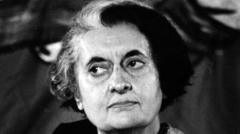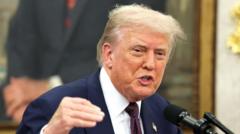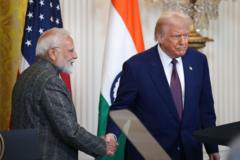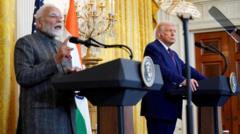In the mid-1970s, Prime Minister Indira Gandhi's authoritarian rule sparked discussions for a centralized presidential governance in India, which, despite being influential on later amendments, never fully materialized.
**Indira Gandhi's Bold Presidential Ambitions: A Glimpse into India's Authoritarian Past**

**Indira Gandhi's Bold Presidential Ambitions: A Glimpse into India's Authoritarian Past**
Exploring the unfulfilled dreams of India's potential shift to a presidential system during the Emergency era.
During the turbulent mid-1970s, India found itself under the oppressive reign of Prime Minister Indira Gandhi, who imposed a state of Emergency that curtailed civil liberties and imprisoned political dissenters. In a striking turn, Gandhi's administration began contemplating a radical transformation of the Indian political system, advocating for a presidential model that would centralize power and suppress the independence of the judiciary and parliament. Historian Srinath Raghavan highlights these ambitions in his recent book, "Indira Gandhi and the Years That Transformed India."
It all unfolded in September 1975, when BK Nehru, Gandhi's close aide, wrote to her celebrating the Emergency as an assertion of political power backed by popular support. He suggested that India required a directly elected president who could make difficult decisions without being shackled by parliamentary obligations. Drawing inspiration from Charles de Gaulle's France, Nehru's proposals included a seven-year presidential term, altered representation in the legislature, and a diminished judiciary. He even suggested that fundamental rights could be stripped of enforceability.
This vision found favor among influential leaders within the Congress party, inciting conversations around a constitutional reassessment. Despite initial enthusiasm, Gandhi remained evasive, directing her inner circle to consider these revolutionary ideas further. A confidential document proposed a president with authority exceeding that of the U.S. president, including oversight of judicial appointments, which would have weakened the Supreme Court’s power.
While the concept of a full-fledged presidential transition never materialized, aspects of these ambitious changes influenced the Forty-second Amendment Act of 1976. This amendment broadened parliamentary powers while constraining judicial review, effectively reshaping India's democratic framework. Critics such as the Statesman newspaper cautioned against the overt shift towards a more authoritarian parliamentary system.
Simultaneously, advocates among party loyalists began fervently pushing for Gandhi to solidify her power indefinitely. However, she opted to accelerate the amendment's passing rather than indulge these radical suggestions. A year later, following her defeat in the 1977 elections, a new coalition government moved to restore democratic norms, erasing many of the prior changes.
Upon reclaiming power in 1980, discussions surrounding a presidential system resurfaced, but Gandhi ultimately chose to appoint her loyal ally Zail Singh to the presidency rather than take the role herself. Despite this flirtation with presidentialism, India remained a parliamentary democracy, reflecting a reluctance for substantial reform within the ruling elite.
Raghavan argues that while there were serious considerations for a shift in governance style, the lack of enduring desire for radical change meant India’s parliamentary structure persevered. The Emergency, although a departure, didn't initiate a long-term agenda but was rather a means for Gandhi to secure her political hold amid significant instability. Even late into the early 1980s, discussions for a presidential system lingered, but were silenced with Gandhi's assassination in October 1984, sealing India's commitment to its parliamentary legacy.




















